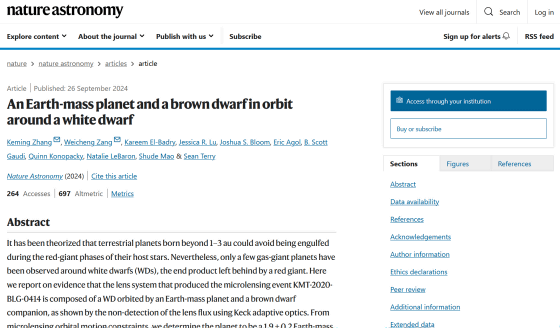A planet similar to the Earth 8 billion years after it was not swallowed by the sun has been discovered 4,000 light years away

Currently, the Earth and the Sun are kept at a distance that is just right for life, but it is predicted that in the next 1 billion years, solar radiation will become so strong that the water on Earth will evaporate, and within 7.5 billion years, the Sun will expand to 256 times its current size and swallow the Earth, but there is also a theory that this will not happen. Astronomers have recently reported that they have found a planet similar to 'Earth 8 billion years from now if it is not swallowed by the expanded Sun' in a star system located 4,000 light years away from Earth.
An Earth-mass planet and a brown dwarf in orbit around a white dwarf | Nature Astronomy

This rocky planet around a white dwarf resemb | EurekAlert!
https://www.eurekalert.org/news-releases/1059118
Astronomers spot a possible 'future Earth' — 8 billion years into its future | Live Science
https://www.livescience.com/space/exoplanets/astronomers-spot-a-possible-future-earth-8-billion-years-into-its-future
A paper published in the academic journal Nature Astronomy reports on a star system called 'KMT-2020-BLG-0414' located near the center of the Milky Way galaxy , about 4,000 light years from Earth. This star system was discovered in 2020 when KMT-2020-BLG-0414 moved in front of an even more distant star about 25,000 light years away, causing a gravitational microlensing effect that distorts space and light through gravity.
When astronomers investigated KMT-2020-BLG-0414, they discovered that at its center is a white dwarf star called ' KMT-2020-BLG-0414L' with about half the mass of the Sun. They also discovered that KMT-2020-BLG-0414Lb, a planet with about twice the mass of Earth, and KMT-2020-BLG -0414Lc, a brown dwarf with about 17 times the mass of Jupiter, orbit around it.
Stars that are not heavy enough to become neutron stars , like the Sun, eventually expand to become red giants , and as their gravity weakens, the gas in their outer layers escapes and they become white dwarfs. White dwarfs are also known as 'stellar remnants,' and it is expected that the Sun will also become a white dwarf in the future.
The research team claims that KMT-2020-BLG-0414Lb, an Earth-like planet orbiting the white dwarf star KMT-2020-BLG-0414L, may resemble 'what Earth would be like 8 billion years from now if the Sun had not been swallowed by the Earth.'
The sun is expected to begin expanding in about 1 billion years, becoming a red giant larger than the Earth's orbit and swallowing Mercury and Venus. However, there is no consensus among scientists as to whether the sun will swallow the Earth when it expands within 6 billion years, or whether the Earth will avoid being swallowed by the sun because its orbit has become farther away due to the loss of the sun's mass.
'Either way, Earth will only be habitable for the next billion years or so,' said lead author Keming Zhang, an astronomer at the University of California, San Diego. 'Our oceans would likely evaporate from a runaway greenhouse effect long before there's a real risk of being consumed by a red giant.'
If the Earth were not swallowed by the Sun, its orbit would remain as far away as it was when the Sun was a red giant, even after it became a white dwarf. The orbit of KMT-2020-BLG-0414Lb is about twice the average distance (

Even if the Sun becomes a red giant and Earth becomes uninhabitable, humans may find refuge in the outer solar system, especially on Jupiter's moons Europa , Callisto , and Ganymede , or Saturn's moon Enceladus , which could have oceans as their frozen surfaces melt with the expansion of the red giant.
'When the Sun becomes a red giant, the habitable zone will move to around the orbits of Jupiter and Saturn, and many of these moons will become ocean planets. In that case, I think humans could live there,' Chang said.
Related Posts:
in Science, Posted by log1h_ik







